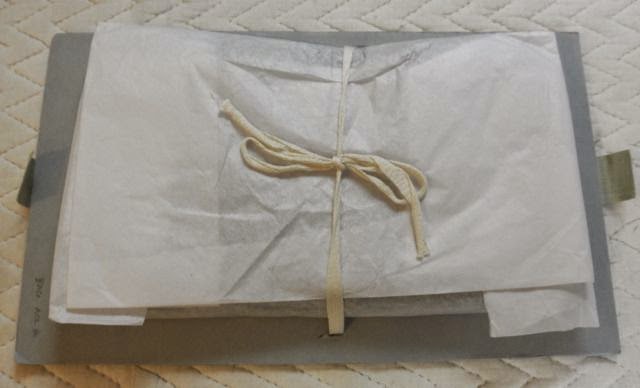Acid-free tissue paper is a basic storage supply used for interleaving, padding, covering, and wrapping. It comes in sheets or rolls. Tissue has been in active use in museums for decades and we have talked about its substitution here in our blog about acid free materials.
Tissue is used in abundance. When I visit institutions, it is most common to find artifacts wrapped in tissue (and occasionally wrapped in Tyvek or other wrapping material). Often when an artifact is delivered to me, or if I am examining it at an institution it is presented just like a gift wrapped package, with the folded ends of the tissue all tucked under the artifact.
 |
| A print wrapped in protective glassine, where the upper and lower edges are folded under. |
Sometimes these packages are then placed into a box surrounded with wads of tissue, making it a treasure hunt of determining which wad is the artifact, and which is just paper. This hunting game is not necessary, nor is it in the best interest of the artifact.
Hats or any type of head-gear seem to be the type of artifact that is the most probable to be stored this way. Especially unfortunate as that hats and head coverings also tend to be embellished with fragile and delicate attachments, like feathers, which are particularly vulnerable to damage when wrapped this way.
As a conservator, I find this type of gift wrapping troublesome. This is because it causes the artifact to be unnecessarily and overly handled. Also, if you do not know a collection, you do not know what is fragile or not. When all is hidden, it necessitates a hunt in the tissue to even find what you are dealing with.
I understand that this type of packing was done with the utmost interest in protecting the collection and certainly that can never be faulted. In addition, there are many (now outdated) manuscripts that had promoted this type of care. But the museum field has now revised their thinking and certainly there are still times when paper is necessary because it is the best choice for an updated method of protection, interleaving, or just general storing.
 |
| A small purse embellished with metallic threads is placed on tissue that rests on a handling tray fitted with twill tape. |
 |
| All of the layers are folded to the top or upper surface of the artifact. |
 |
| Wrapped layers are all accessable without need to lift or handle the artifact. |
While unwrapping the above artifact, it did not need to be lifted or handled to be seen. The paper was folded and positioned in such a way that it was both protective of the artifact, while also being accessible.
Another solution is not to wrap at all. Here is a pair of epaulettes and their original box, both secured on Ethafoam supports and protected within an archival box.
_____________________________
Gwen Spicer is a textile conservator in private practice. Spicer Art Conservation specializes in textile conservation, object conservation, and the conservation of works on paper. Gwen's innovative treatment and mounting of artifacts is unrivaled. To contact her, please visit her website.
Another solution is not to wrap at all. Here is a pair of epaulettes and their original box, both secured on Ethafoam supports and protected within an archival box.
_____________________________
Gwen Spicer is a textile conservator in private practice. Spicer Art Conservation specializes in textile conservation, object conservation, and the conservation of works on paper. Gwen's innovative treatment and mounting of artifacts is unrivaled. To contact her, please visit her website.


No comments:
Post a Comment